
views
Teaching the Canter
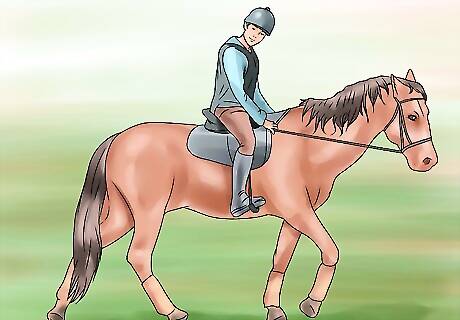
Teach your horse to trot and walk before starting. As some horse experts might tell you, "you can't teach the canter from the canter." Horses need good foundational knowledge of the trot and walk (plus the muscle strength that comes from learning these commands) to learn the canter properly. Without this, your horse may have difficulty maintaining safe canter form, which can be bad for you and (especially) the horse. This is extra true with young, inexperienced (or "green") horses. Since the canter is what's called a "three-beat gait," it puts the horse's entire body weight on the outside hind leg when it steps off. Young horses typically don't develop the strength necessary to do this safely without good foundational training.
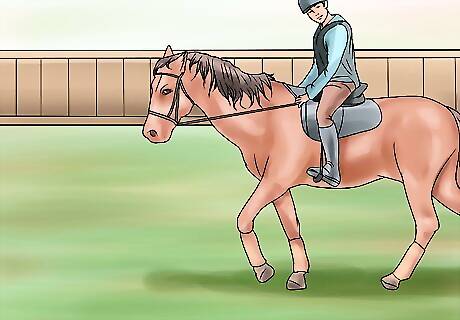
Start trotting in a wide circle. The canter should be taught in a flat, open space that's at least about 60 feet (about 20 meters) wide. Begin by trotting at a steady, comfortable pace (in whichever direction is easiest for you to control.) Horses need lots of space to balance properly as they're learning the canter, so don't skimp and use a space that's too small. In some cases, a lack of space can even lead some horses to become panicky or agitated. Note that, at this point, the horse should be tacked up with bridle, saddle, side reins, and boots. If the horse has any rubs or abrasions caused by the halter, it is not a good fit. The halter should hang below the horse's cheekbone so that you have control over the head, but do not cause distress on any of the pressure points of the horse that may impede the way that they breathe. It should not put unnecessary pressure behind their ears. That region is called the poll and is extremely sensitive. So make sure you do not have something that hurts them behind their ears or the back of their head.
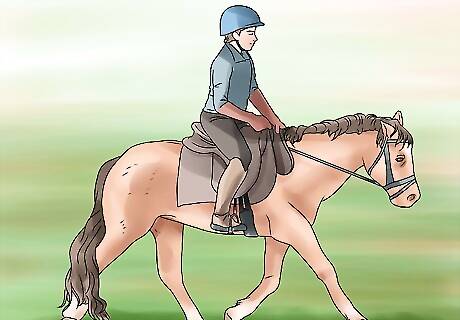
Perform a few basic transitions to get the horse's attention. Before you teach the canter the first time, you want your horse attentive and responsive to you. To do this, give the horse a few commands that it already knows. For instance, try transitioning between a walk and a trot and back again a few times until the horse is sharp to your commands and is responding instantly.
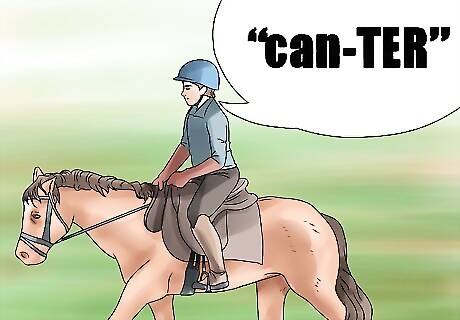
Ask the horse to canter. Now, you're ready to perform the canter command. Get the horse moving in a wide circle at a trot once again. When you're ready, say "can-TER" in a sharp (but not angry) voice. The goal here is to associate your verbal command with the act that you're about to ease your horse into doing — eventually, your voice alone should be enough to get a good canter from your horse. When you make this command, you'll execute a few commands with your body (described in the next step) simultaneously. For more detail on these body cues, see the section below.
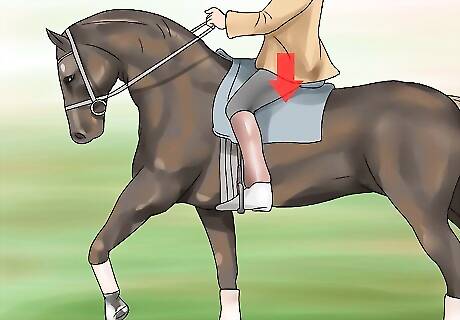
Encourage the canter with your lower body. As soon as you give the "can-TER" command, slide your inside hip (the side pointing to the inside of the circle you're trotting in) forward and your outside hip backward. As you do this, squeeze with your inside leg and slide the outside leg back. Ideally, the horse should interpret your actions as a command to go faster. See the section below for greater detail and for information on proper form and posture once you begin to canter. Note, however, that if the horse doesn't seem to notice your command, you can use a lunge whip or another riding aid (gently) to get its attention. However, this works best if the horse is already comfortable using these aids — if not, they may confuse it.

Repeat your command if the horse starts to trot faster. If, after giving the canter command, the horse stays in a two-beat trot and doesn't transition into a three-beat canter, give the command (and the body motions) once again. The horse should go faster still. If necessary, repeat the command again. After a certain point, it will need to transition from the trot to the canter to go any faster. Once your horse transitions into the canter, be sure to reward it by praising enthusiastically with your voice. If you desire, pat the horse on the neck. Over time, these rewards should associate following your commands with positive feelings in the horse's mind.
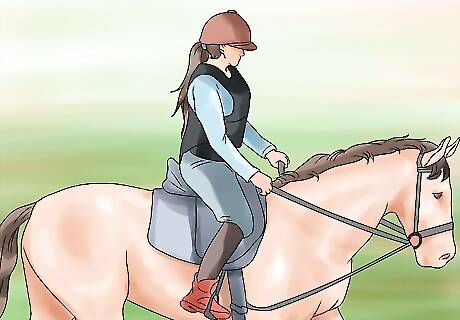
Ease back into a trot when the horse fatigues. Believe it or not, a basic canter can be quite fatiguing to a young horse that hasn't built up its riding muscles yet. Be attentive to your horse's movement as it canters underneath you. As soon as you feel the canter begin to become unbalanced or off-rhythm, transition back into a trot and immediately give a half-halt command to get the horse's movements back under control. See the section below for more detailed information on performing a half halt. Note that, at first, a horse may be able to do less than a single full circle of cantering at once. This is OK — with frequent practice, the horse will become stronger and more confident. Using an experienced rider as an observer can help immensely here.

Repeat the cantering commands. Get your horse trotting in a circle again and repeat the steps above to start another canter. Repeat this several more times, staying conscious of your horse's fatigue as you do so. You may notice that your horse becomes more responsive to your commands within a single training session. If not, be patient — this will come with time. Keep training sessions short at first so that the horse doesn't become overly tired or lose interest. A training session of about 20 minutes is fine for the first month or so of training.

Vary your practice over the next several months. When you're riding your horse "for real", you won't be limited to simply cantering in a circle. To give your horse the sort of versatility that it will need for cantering in practical situations, try changing up your training routine once it's comfortable with the one described above. A few good ideas are: Canter and trot in figure-eights to get your horse used to turning to both sides. Trot tight circles at the corners of your training area, making your horse canter from one to the next in sequence. Canter and trot in a long, winding course of your own design. After a month of training, try executing a half-halt during a canter.
Perfecting Your Riding Technique
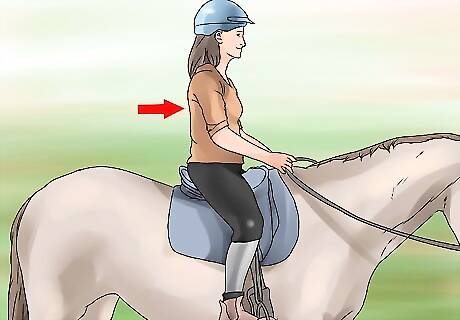
Start with open, erect riding posture. While professionals may make it seem effortless, a good canter results as much from the rider's efforts as it does from the horse's. As you canter, your body should be positioned to open the front (leading) shoulder of the horse and to cue the horse behind the girth, all while adding forward movement. Assume the following posture while you trot to prepare to transition into a canter. Keep your back straight. Keep your chest up. "Open" your chest by drawing your shoulders back gently. Use the core muscles of your hips and abs for balance. Ideally, you should be able to canter without pulling on the reins, pommel, or saddle horn to steady yourself.
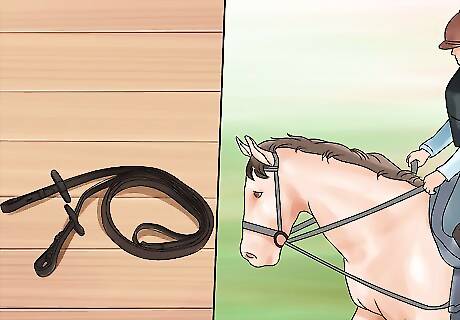
Open your horse’s shoulder with the reins. As you work into the canter, maintain good rein contact contact, but open the inside rein of your horse while holding a firm grip on the outside rein. This will give your horse important support on the diagonal beats. Note, however, that the goal here isn't to support the horse too heavily, as it needs to develop its own sense of balance while cantering.
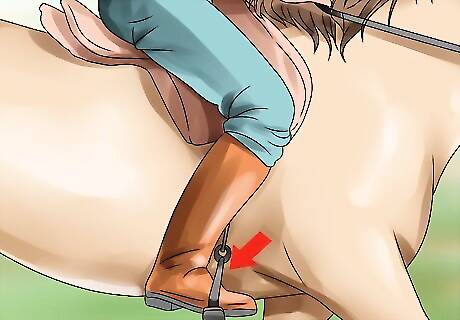
Use body cues to ask for a canter. As described in the section above, cuing a horse to canter involves several simultaneous motions of the rider's body. Follow the steps below to start cantering: Turn your torso and shoulders (keeping your hips straight ahead) so that your shoulder on the outside is positioned slightly further back than your shoulder on the inside. Move your outside leg back. As you do this, give pressure with your inside leg and slide your inside hip forward slightly. Use the inside rein to pick up the correct lead. This also opens up your horse’s leading shoulder, helping them to understand your intentions while keeping their movement "collected." Using your rear leg, squeeze your horse’s barrel and ask for increased speed. Note that some horses are also trained to shift into a canter when you cue them with a "kissy" noise (different than clucking for increased speed), so you may need to do this at the same time. Make sure you are cuing your horse behind the girth — that is, with your feet a few inches back from where they would ordinarily hang. In addition, try not to move your hands forward. These mistakes can get you a fast trot or a side-pass.
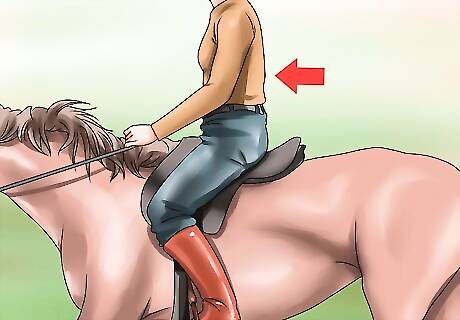
Sit the canter. One of the best things about the canter is that it's actually fairly easy to ride. Unlike a trot, a canter is very smooth for the rider, giving a "More floaty" feel rather than the "bumpier" one of the trot. However, it is possible to ride the canter incorrectly, so use the steps below to ensure you're sitting correctly: Hold the reins without pulling on them. Just like when you cued the canter, you should have increased contact on the outside rein and light contact on the inside rein. If you feel out of control and are pulling on the reins for balance, then you're going too fast and you should slow your horse down. Stay balanced in an erect, upright posture. Don’t lean forward or to the inside. Although it may feel like the other way around, the horse actually gets much of its ability to balance based on what you’re doing on its back. If you’re out of balance and tipped forward and in (as many inexperienced riders have a tendency to do), your horse will have a hard time not doing the same. Avoid gripping with your legs. As with trotting, it can seem instinctual to “hold on” to the horse using your legs. However, this will give the horse mixed signals, as it's usually a cue to speed up. Similar to tugging on the reins, if you feel like you can't stay in the saddle without gripping with your legs, slow down until you can remain seated comfortably.

Be ready to cue a half-halt. A half-halt is essentially a partial stop, just as its name suggests. The half halt can be performed at any speed and is done similar to the way you would cue a regular halt. This technique gets your horse’s rear feet on the ground, which gives it the necessary strength and balance to either start a collected canter or get their movements under control. You don’t have to cue a half-halt in order to canter, but doing so will give your horse better grounds for moving into the faster gait. Use the steps below to cue a half-halt: At a canter, maintain a soft supporting leg as you sit up and brace your back in preparation for a halt. Let your elbows come back and put a little pressure on the reins as if you're asking to transition into a trot. As soon as you feel your horse respond, add more leg, soften your fingers on the rein, and resume cantering. This may feel like you're asking your horse to "canter in place" for a brief moment.
Avoiding Common Mistakes
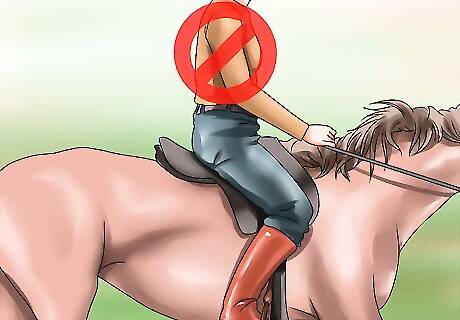
Avoid rocking your shoulders. Old-time Western movies have popularized images of cowboys cantering away on their horses with their entire body moving in sync with the horse. While it is a good thing for your hips to move, your torso and shoulders should not sway or rock in time with the horse. This can put both you and your horse off balance, making the canter difficult to sit.

Keep your heels down. This is often a problem at any faster gait for beginning riders. Your foot should be situated in the stirrup so that you are putting your weight on the ball of your foot with your toes tipped up slightly and your heel tipped down. This keeps you in balance and helps prevent you from leaning forward or gripping with your legs. If you have a hard time doing this, your stirrups may be too short. English stirrup irons should be at about ankle bone-height, while Western-style stirrups should be long enough to leave a slight bend in your knee.
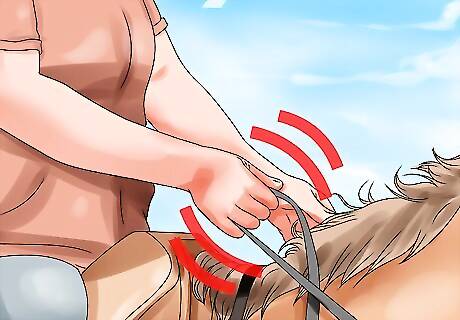
Keep your hand motions subdued. It can be difficult to keep your hands stationary while the horse is trotting or cantering beneath you. However, if your hands move too much, they can yank at the reins, which can be very confusing for the horse. Try to move your hands only as much as feels natural from the horse's movement — this should get easier with experience. If you need help keeping your hands still, try gently gripping your horse's mane with your pinkies. The tug of the mane will help keep your hands centered and in-sync with the horse's natural movement.
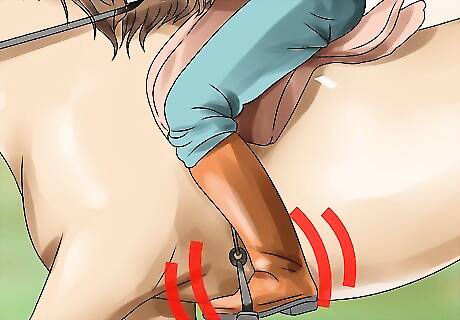
Avoid swinging your legs. As your hips naturally shift with each of the horse's strides, it can be easy to let the motion carry into your legs as well. This, however, is a bad idea, as excessive leg motions can confuse the horse. Try to keep your leg in the proper "behind the girth" riding position for maximum control and sharp responses from your horse. If you need help, try keeping your heels down in the stirrup (as suggested above.) This tends to naturally push your legs back into the proper position.
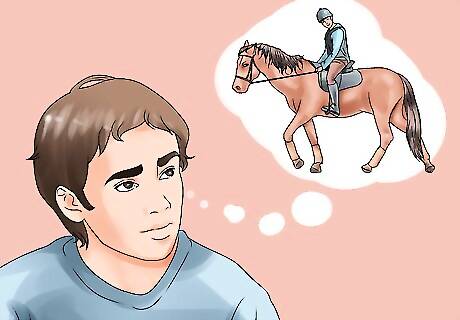
Don’t go into the fetal position. The so-called "fetal" position is a riding mistake that involves leaning forward (sometimes to grab a handhold on the mane, horn, pommel, or reins), gripping with your legs, tipping your toes down and bring your heels up. This a usually a nervous response done in hopes of maintaining balance and preventing the rider from falling off, but, unfortunately, it does just the opposite: it throws your horse out of balance and speeds the horse up. Good self-control while riding is important to avoid this. When you get anxious, slow your horse down a bit, loosen your legs and lean back. Even if you feel like you’re leaning back too far, odds are that you’ll probably be perfectly vertical (which is good cantering posture.) Resist the urge to "hunker down" and grip tightly — remember, this will give you the opposite of what you want.
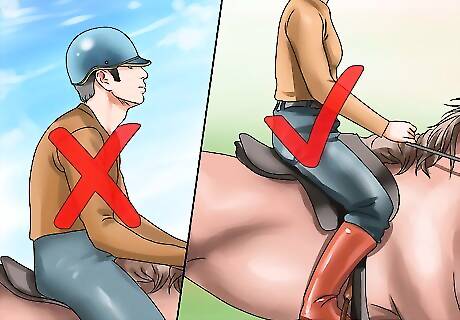
Don’t slouch. It’s not a good habit in general to slouch your shoulders and curve your back while riding, and it is a particularly poor idea when you’re cantering. Make sure your shoulders are always upright and positioned over your hips. This gives you better balance and keeps you from accidentally urging your horse to go faster (see above.) If you need help maintaining your posture, try using a long crop slid behind your back and in the crook of each elbow while you ride. This will prevent you from slouching forward and will help your arms stay in the correct riding position as well.
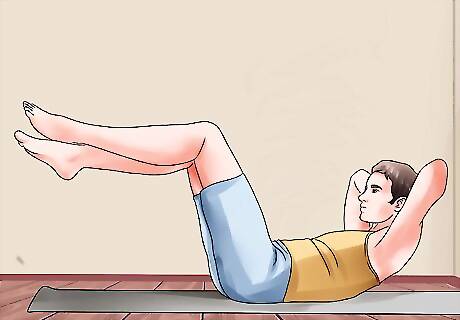
Keep your core strong. Core strength is essential for cantering, as riding a horse (especially at higher speeds) is a workout that uses the core muscles heavily. Even if you do everything else correctly (shoulders back, heels down, upright position, etc.), if you go soft in the middle this can cause you to lose your center of gravity. Keeping yourself centered with a firm core will help your horse maintain a collected canter and make things easier and more comfortable for you in the long run as you teach your horse new skills. If you feel like your core muscles aren’t up to par, you may want to practice doing the plank exercise in your free time. Get in pushup position, but balance on your elbows with your forearms laying along the floor. Hold this position for as long as you can, take a one-minute rest, and repeat three times. If you do this every day, you should notice a significant difference in your balance while riding.

















Comments
0 comment